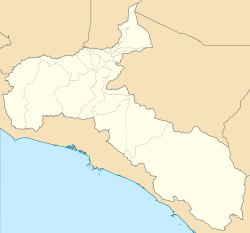You can help expand this article with text translated from the corresponding article in Spanish. (July 2024) Click [show] for important translation instructions.
|
Desamparados | |
|---|---|
 Desamparados canton | |
| Coordinates: 9°48′41″N 84°01′44″W / 9.8114083°N 84.0289552°W | |
| Country | |
| Province | San José |
| Creation | 4 November 1862 |
| City | Desamparados |
| Districts | |
| Government | |
| • Type | Municipality |
| • Body | Municipalidad de Desamparados |
| • Mayor | María Antonieta Naranjo Brenes (PLN) |
| Area | |
| • Total | 118.89 km2 (45.90 sq mi) |
| Elevation | 1,270 m (4,170 ft) |
| Population (2011) | |
| • Total | 208,411 |
| • Estimate (2022) | 223,226 |
| • Density | 1,800/km2 (4,500/sq mi) |
| Time zone | UTC−06:00 |
| Canton code | 103 |
| Website | www |
Desamparados is the 3rd canton in the province of San José in Costa Rica. The canton covers an area of 118.89 km2 (45.90 sq mi),[1] and had a population of 223,226 in 2022,[2] making it the third most populated among the 81 cantons of Costa Rica. The canton's capital city is also called Desamparados.
The canton begins in the southern suburbs of the national capital city of San José, with the Tiribí River marking its northern boundary. It snakes its way south as a backward letter S, finally reaching its southern limit at the Tarrazú River. It contains the bigger of the last forest lungs in the Greater Metropolitan Area, the Loma Salitral, which conservation issues have generated social conflicts between community environmentalists and immobility developers, as it is seen as an identity mark of the desamparadeño people and a vital infiltration area to prevent the frequents and disastrous floods in the district of Gravilias.[3]
Urban areas claim 80.4% of the canton's population. Those under age 10 comprise 19.8% of its inhabitants, while 5.1% are over 65.
- ^ "División Territorial Administrativa, 2024 – Totales de Provincias, Cantones y Distritos de Costa Rica" [Administrative Territorial Division, 2024 – Totals of Provinces, Cantons and Districts of Costa Rica] (PDF). Instituto Geográfico Nacional de Costa Rica (in Spanish). 20 June 2024. Retrieved 16 July 2024.
- ^ Instituto Nacional de Estadística y Censos (July 2023). "Resultados Estimacion de Poblacion y Vivienda 2022" [2022 Population and Housing Estimate Results] (XLSX) (in Spanish). Archived from the original on 2024-06-04. Retrieved 2024-04-21.
- ^ "Sala IV resuelve a favor de la protección de la Loma Salitral en Desamparados".



